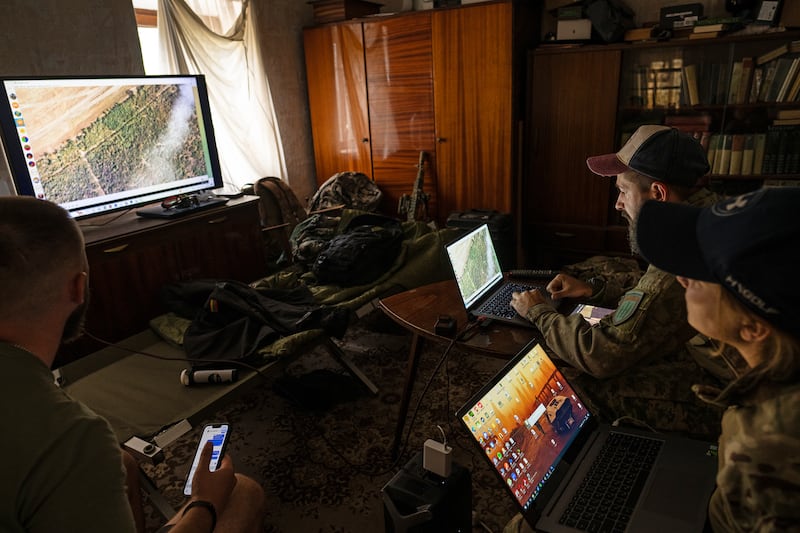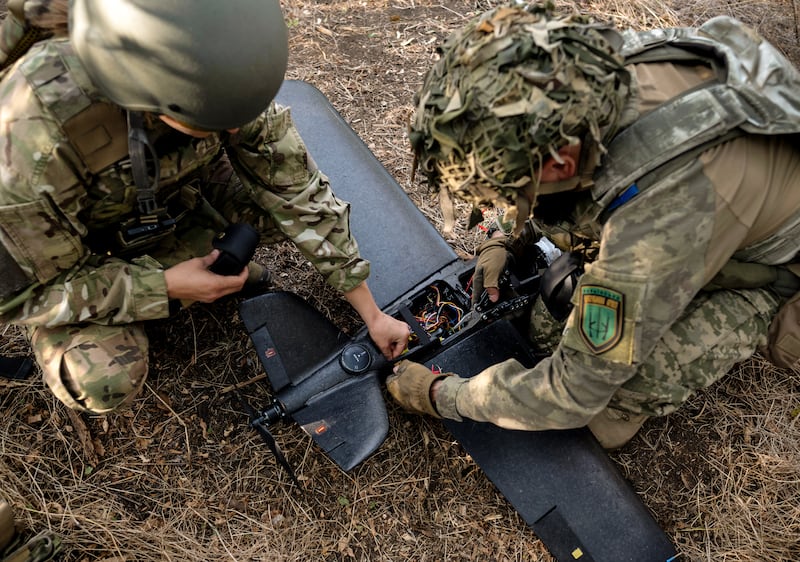They are made of plastic or plastic foam, weigh only a few pounds and are often launched simply by having a soldier throw them into the air as if tossing a javelin.
In a slow-moving counteroffensive against Russian forces that has been reliant at times on the smallest advantages, a fleet of cheap, mostly off-the-shelf drones is providing one for the Ukrainians.
The drones have begun to make a difference in one corner of a stagnant war, soldiers, commanders and pilots said in interviews, because their different materials and variable frequencies can evade enemy jamming systems. That has allowed them to venture farther in searches for enemy artillery positions and multimillion-dollar air defence systems, all the while risking aircraft worth only a few thousand dollars apiece.
Along one of their two main Ukrainian lines of advance in the south, they say, the Russian army has been forced to move its howitzers out of range of Ukraine’s guns as drone pilots have adapted well enough to regularly evade Russian electronic jamming systems that had been spotting them reliably earlier in the war.
READ MORE

The fighting has come down to small steps with high stakes for Ukraine as president Volodymyr Zelenskiy sought on a visit to the United States to dispel the sense of stalemate and shore up diplomatic and military backing for a longer fight. With sufficient modern weapons the tide will turn more swiftly on the battlefield, Zelenskiy has argued.
In the months since the Ukrainian counteroffensive began in June, Ukraine’s push to drive a wedge through Russian forces in the south has been a gruelling, bloody infantry fight, with advances sometimes measured in yards. In most aspects Russia holds an advantage in firepower, while also benefiting from fighting from well-prepared defences.
But starting in the summer a flurry of tweaks to drone designs and radio frequencies began to allow Ukrainian pilots, who had initially lost dozens of drones in the opening weeks of a counteroffensive in the south, to send their drones far beyond the front line – drifting high above farm fields and villages – in search of Russian artillery pieces, tanks and other targets, even as those same targets hunt the Ukrainians.
“Oh, a missile flew past,” one drone pilot said calmly after a plume of white smoke appeared only yards from the drone he was piloting during a flight last week. “It means we flew over something interesting.”
The pilot, who asked to be identified only by his nickname Hacker for security reasons, and other members of his unit would later review the drone’s video for clues to what the air defences were protecting – possibly a Russian artillery position, a jamming station or a garrison.
So many small drones are flying now along one section of the front line that Ukraine’s military co-ordinates the flights with a dispatcher, akin to air traffic control.
“If the Russians get close, we will see them,” said Lieut Ashot Arutiunian, the commander of the drone reconnaissance unit.
After 19 months of fighting the war has settled into mostly static but bloody back-and-forth battles. Most recently the Ukrainian military has been fighting to deepen and widen two bulges pushed into Russian defences in the country’s south, and to advance on the outskirts of the eastern city of Bakhmut.
Zelenskiy has publicly ruminated on the counteroffensive’s flaws, saying his country waited too long for Western armoured vehicles, a delay that allowed Russian forces to entrench and lay minefields. Yet just as Ukraine has shifted tactics in the ground fighting by sending small infantry units to clear trenches ahead of armoured vehicles, drone units have adapted too.

Drones made of plastic foam or plastic are harder to find on radar, reconnaissance teams said. Ukraine buys them from commercial suppliers who also sell to aerial photographers or hobbyists around the world, along with parts such as radios, cameras, antennas and motors. The drone units mix and match parts until they find combinations that can fly past sophisticated Russian air defences.
Operators also switch between frequencies midflight or fly close to the ground to evade Russian units trying to track them. Unlike some military drones, Ukraine’s simpler versions fly without GPS navigation, which is both an advantage and a disadvantage; without it pilots and their navigators instead must rely on landmarks on the ground such as buildings, roads or intersections to find their way.
Even as they hunt the Russians, though, they are being pursued by enemy drone teams themselves. At one point the buzz of an unknown drone filtered down through the leaves above to Ukrainians. Commanders ordered everyone to remain motionless. Russian drones regularly overfly the positions of drone reconnaissance units, a few hundred yards up, and pilots are a priority target.
Operators have been killed by Russian units who triangulate the radio signals of the antennae used to control the drones and then call in artillery, aerial bombardments or so-called kamikaze drones that explode, Arutiunian said.
The solution Arutiunian’s teams have created – using drones with few metal parts and frequently shifting radio frequencies – will most likely work for a few weeks, he said, before Russian forces make their own adjustments and find a way to jam the signals or shoot down the Ukrainian drones. Meanwhile, he said, “we are already working on something else.”
– This article originally appeared in The New York Times.



















